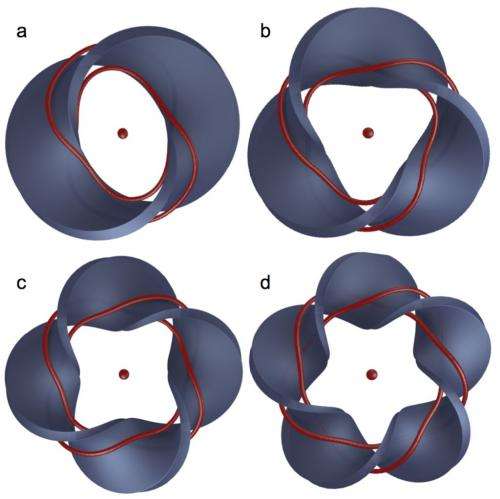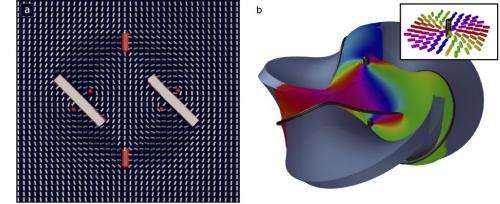Mobius strip ties liquid crystal in knots to produce tomorrow's materials and photonic devices

University of Warwick scientists have shown how to tie knots in liquid crystals using a miniature Möbius strip made from silica particles.
By tying substances like this in knots, the researchers hope to understand how their intricate configurations and unique properties can be harnessed in the next generation of advanced materials and photonic devices.
Liquid crystal is an essential material in modern life – the flat panel displays on our computers, TVs and smartphones all make use of its light-modulating properties.
It is composed of long, thin, rod-like molecules which align themselves so they all point in the same direction. By controlling the alignment of these molecules, scientists can literally tie them in a knot.
To do this, they simulated adding a micron sized silica particle – or colloid – to the liquid crystal. This disrupts the orientation of the liquid crystal molecules.
For example, a colloid in the shape of a sphere will cause the liquid crystal molecules to align perpendicular to the surface of the sphere, a bit like a hedgehog's spikes.
Using a theoretical model, the University of Warwick scientists have taken this principle and extended it to colloids which have a knotted shape in the form a Möbius strip.

A Möbius strip with one twist does not form a knot, however with three, four and five twists it becomes a trefoil knot (like an overhand knot with the ends joined together), a Solomon's knot or a cinquefoil knot respectively.
By adding these specially designed knotted particles they force the liquid crystal to take on the same structure, creating a knot in the liquid crystal.
Gareth Alexander, Assistant Professor in Physics and Complexity Science, at the University of Warwick said: "Knots are fascinating and versatile objects, familiar from tying your shoelaces.
"Recently it has been demonstrated that knots can be created in a variety of natural settings including electromagnetic fields, laser light, fluid vortices and liquid crystals.
"These knots are more intricate than those in your shoelaces, since it is the entire continuous material, and not just a piece of string, that is knotted.
"Our research extends this previous work to apply to liquid crystal, the substance we use every day in our TVs, smartphones and computer screens.
"We are interested in this as creating and controlling these intricate knotted fields is an emergent avenue for the design of new metamaterials and photonic devices."
More information: The study, published in the journal PNAS, is entitled "Knots and nonorientable surfaces in chiral nematics" and is authored by Thomas Machon and Gareth Alexander, both jointly based in the Department of Physics and the Centre for Complexity Science at the University of Warwick. www.pnas.org/content/early/201 … /1308225110.abstract
Journal information: Proceedings of the National Academy of Sciences
Provided by University of Warwick




















